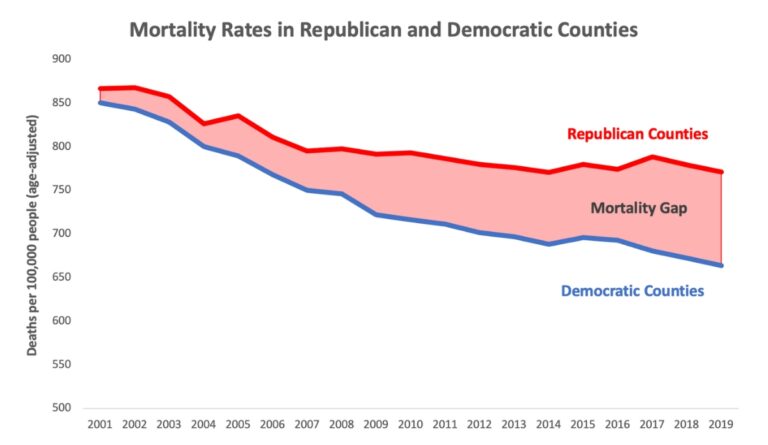Grave Political Consequences
As American polarization continues to rise, state policies are widening a mortality gap along political party lines.

Read Time: 2 minutes
Published:
Death records revealed a troubling trend around the U.S. in 2021. As COVID-19 vaccination became more and more politicized, fewer Republicans lined up to get their shots, leaving them more vulnerable to the virus. The higher death rate among Republicans, however, was not entirely explained by COVID-19. Partisan differences began decades ago.
Haider Warraich and colleagues examined recent trends in U.S. mortality rates based on county-level presidential voting patterns. They compared CDC mortality data with county voting data from the past 19 years, covering five elections: Bush (2000 and 2004), Obama (2008 and 2012), and Trump (2016).
From 2001 to 2019, the mortality gap between Democratic and Republican counties grew more than sixfold. While Democratic counties saw a 22% decrease in their death rates, Republican counties only saw an 11% decrease. The greatest contributors to the widening mortality gap were heart disease, cancer, and chronic lower respiratory tract diseases (emphysema, asthma, COPD, and chronic bronchitis).
The authors suggest that the widening gap in mortality rates may be explained by growing differences between Democratic and Republican state policies.
Democratic leaders have been more likely to expand health care and implement policies addressing the social factors that influence life expectancy, including tobacco control, the minimum wage, civil rights, social welfare, and environmental protections. For example, Democratic states were more likely to expand Medicaid under the Affordable Care Act, making health insurance coverage accessible to millions of people with low incomes.
Republican leaders have often been less supportive of social welfare programs like the Temporary Assistance for Needy Families (TANF), the primary government program associated with cash welfare. Republican-controlled legislatures have not changed state policies associated with lower life expectancy, such as restrictions on abortion and lax gun control, instead adding strict requirements to safety net programs like the Supplemental Nutrition Assistance Program (SNAP) and Medicaid.
Where a person lives contributes to their life expectancy. As American polarization continues to rise, politics continue to widen a partisan mortality gap.
Databyte via Haider J Warraich, Pankaj Kumar, Khurram Nasir, et al. Political environment and mortality rates in the United States, 2001-19: population based cross sectional analysis. BMJ, 2022.



